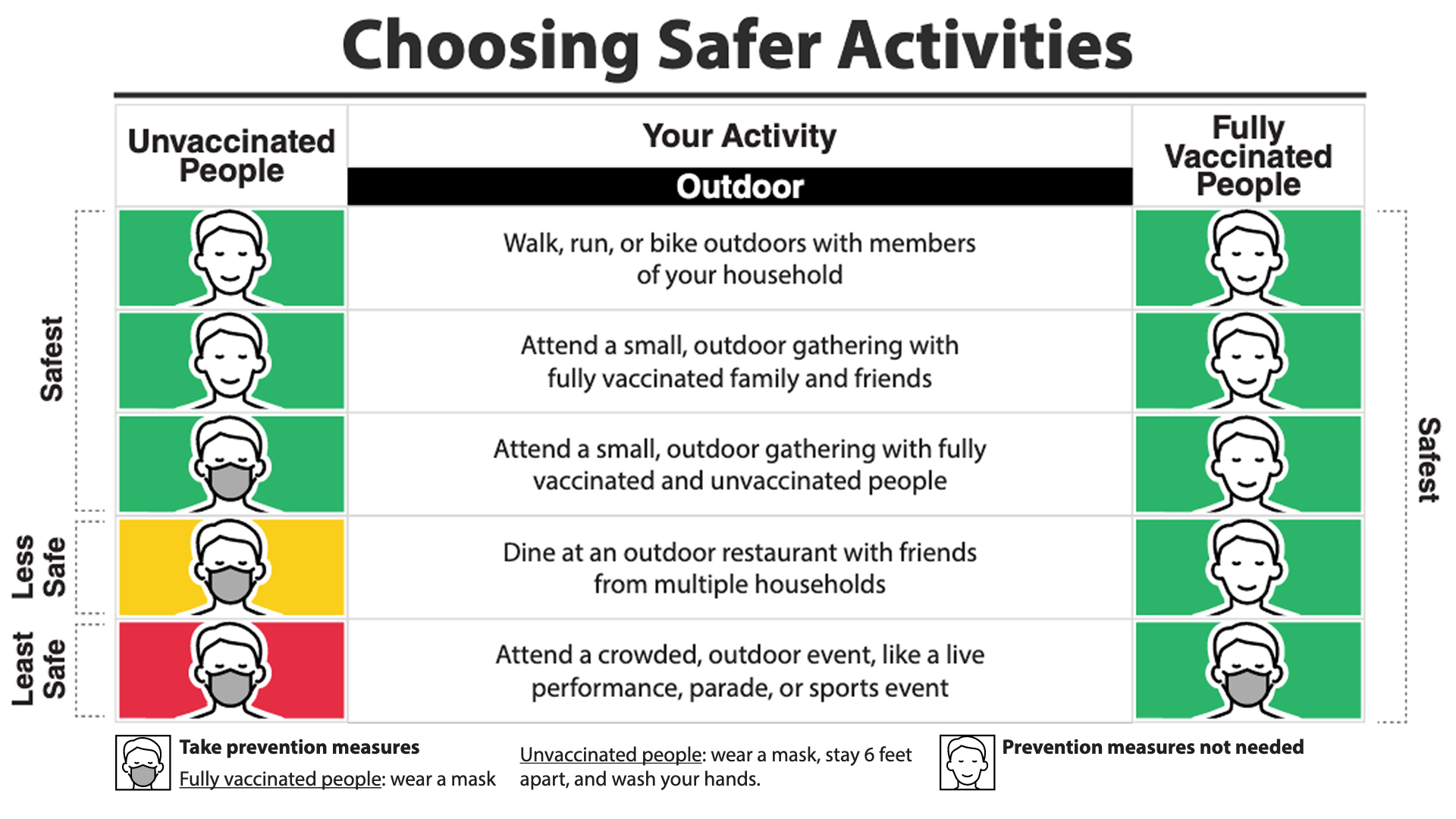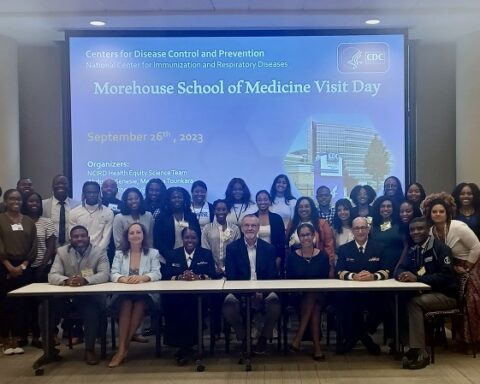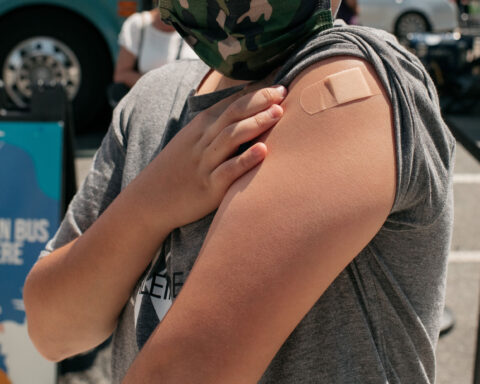New mask guidance from the US Centers for Disease Control and Prevention this week has divided experts and fueled a new debate about the best way to steer Americans out of the pandemic.
The guidance boils down to this: Fully vaccinated people can now unmask at small outdoor gatherings, or when dining outside with friends from multiple households. The CDC is telling unvaccinated people that they still need to wear a mask at such gatherings.
Some public health experts have cast the new guidelines as too cautious as health officials pivot to reaching vaccine-hesitant Americans, while others point to concerning variants and the possibility of a winter surge as reason to keep encouraging widespread mask use.
CNN posed a few key questions about the new guidance to three experts: Epidemiologist Ali Mokdad, a professor of health metrics sciences at the Institute for Health Metrics and Evaluation at the University of Washington; CNN Medical Analyst Dr. Leana Wen, an emergency physician and visiting professor of health policy and management at the George Washington University Milken Institute School of Public Health; and vaccine scientist Dr. Peter Hotez, dean of the National School of Tropical Medicine at Baylor College of Medicine.
They had a range of views about the new mask guidance and whether it’s appropriate at this point in the pandemic. Excerpts from those conversations, conducted over the phone separately and lightly edited for flow, are below:
Too early or not soon enough?
President Joe Biden came into office pledging to encourage — and, where he could, enforce — mask mandates, but now is in the position of encouraging people to get vaccinated so they can stop wearing masks outside as the US moves toward a return to normalcy. But there’s no agreed-upon roadmap for navigating that shift.
Mokdad: It’s very simple. How can I tell who is vaccinated and who is not? When I’m at an outdoor restaurant, how can I tell if — what is a crowded place? Is a farmer’s market in summer crowded? How do I define crowded as a single person? Also, how could CDC release something that is one size fits all?
How could we send this message to everybody across the US that it’s safe and you’re equally safe, irrespective of your vaccination level? What about variants? We have the new variants that are making the vaccines less effective, but the masks do protect from these variants. So why are we sending this message saying, it’s all clear for ditching the mask and encouraging people not to wear the mask?
I mean, people wear the mask when they see others are wearing the mask. And that’s very important that we need to reinforce that message, that even people who are vaccinated, who listened to us and did what we asked them to do, they’re more likely to listen to us to wear a mask. Why are we telling them ditch the mask? I mean, we need to focus on the risk.
That linking — mask to vaccine — I didn’t like it at all.
And come winter, our biggest problem is we know this virus is seasonal. Cases are going to increase. We may have new variants coming from India with about 15 million cases a day right now. We’ll have new variants arriving in the United States. They’re most likely to be escape variants from what we know from the limited testing.
So what? Are we going to reverse? How could we convince the public again and say: ‘hold on a second. You’re vaccinated but now you need to wear your mask outdoors and indoors.’ I don’t understand it. I don’t understand it. I’m really puzzled by what CDC did.
I understand. We are afraid that — we want to encourage people to get the vaccine, but that’s not the right way.
—
Wen: I think it’s still far too cautious. I do think that it’s moving in the right direction. What I mean is, specifically, I think it’s a really good thing that the CDC is finally differentiating between what it is that fully vaccinated people could be doing versus what is it that you cannot yet do safely if you’re not vaccinated.
I think they need to very clearly give the benefits of vaccination. And so very clearly stating ‘here are the differences between what you can do if you’re vaccinated or unvaccinated’ — I think very much helps.
The indoor galleries component, which we didn’t talk about, is actually also really important because the CDC is saying all of those activities that were previously considered to be higher risk — for example, dining indoors, going to the gym, singing in a choir, all these things that were higher risk are now much lower risk if you’re fully vaccinated.
So I think that’s good that they are differentiating between vaccinated and not vaccinated and showing the benefit of vaccination.
I also think, though, that at this point, people are beginning to ask the question, what’s the point of getting vaccinated? Both things can not be true if you’re saying this vaccine is so effective at reducing infections and protecting individuals from spreading coronavirus, how could it be that I still can’t do these activities without wearing a mask. And I think that’s where the CDC — I think they could have gone much further.
—
Hotez: I think the mask guidance itself is fine. The weakness in it is it wasn’t contextualized. It wasn’t put in the framework of where the country is heading.
And so to just provide one-off guidelines without the context of how we’re doing as a country in terms of vaccinating the American people and when we expect transmission to go down with the understanding that this current guidance is version 2.0, and as we hit 60% of Americans being vaccinated, then we’ll be in version 3.0 because the numbers will start to decline in terms transmission due to vaccination. And then by the summer we’ll be a 4.0.
And I think if they had done that, it would have been more effective because people would understand the road map. People would understand where they’re heading and this has been the problem all along with communications out of Health and Human Services. It’s not contextualized, it’s not synthesized, it’s not put into a framework. All the kinds of things that I tell my first-year graduate students they have to do, that’s not what gets done by Health and Human Services.
Is the new guidance clear enough for people to follow?
A key pillar of public health messaging is making sure people can understand it. The CDC’s new guidance — and the accompanying chart — has also prompted a debate about what people will actually take away from the new guidelines.
Here’s what Mokdad and Wen said:
Mokdad: My concern is the following: People will remember one thing — I don’t need to wear a mask and that’s my biggest concern. And it’s confusing.
As you can see, it’s not clear. There’s so much gray area in there and people are going to do whatever they feel works for them in different settings. And that’s my biggest concern. It’s not clear, it’s not specific. And it’s going to leave room for interpretation by different people differently. And that will lead to a lot of problems.
What if a guy goes to a restaurant and wants to sit at a table next to my table, and they’re not six feet apart and they say ‘I’m vaccinated.’ Will the restaurant owner say show me you are vaccinated. I mean, how do we know who is vaccinated and who is not?
—
Wen: I think that in [the CDC’s] defense and the defense of governors and mayors who still have outdoor mask mandates in place, they want to make it simple. They want to make rules easy to follow, but I also think that Americans can handle the nuance.
Americans can make decisions for ourselves, and I think a lot of people take it the wrong way, but our government thinks that they know what’s best for us — that we can’t think for ourselves. I think people can handle — many months ago, they can handle the very basic edict of you need two out of three things: masks, distancing and outdoors. So if you’re outdoors and can’t mask, you need distancing. If you’re outdoors and your distanced, you don’t need masking.
I think we could have handled that. And to say that, ‘Oh, we need to make it simple,’ — it doesn’t treat Americans with the respect that we deserve.
Enough incentive for the vaccine hesitant?
One key question about the new mask guidance is whether it provides enough incentive for people who are hesitant to get vaccinated to go through with inoculation.
Mokdad: Very simple, these vaccines that will save your life. Even if you get Covid-19, you’re not going to end up in the hospital. You’re not going to die from Covid-19. I mean, this is going to save your life. How did we convince people to wear a seat belt? They save your life and we put some enforcement on it. How did we convince people not to smoke? I mean, we have to be patient. We have to work with it.
We have to address it, but we cannot tell people before we get herd immunity you can ditch your mask. We have to do our job. We’re avoiding doing our job by giving in, saying don’t wear your mask if you get vaccinated. I don’t see it.
Let me say in full disclosure, we are going to be okay this summer. We’re going to be close to a normal summer, simply because vaccines and the seasonality. But come winter? No. We are going to be in a bad position.
—
Wen: The longer they wait to provide that kind of clear guidance, the more it is that people are returning back to their lives regardless of vaccination. And then we’re going to totally miss the window, right?
If everybody is already going to endure church, and gym, and choir service regardless of vaccination status, there is no more incentive to offer. I think we may have already missed the window for tying reopening policy to vaccination status. But certainly the CDC has not done a lot of favors in this regard because the guidance is still far overly cautious.
There are a lot of Americans for better or for worse — again, I don’t necessarily agree with this — but there are a lot of Americans who see the end of mask-wearing as the return to normalcy.
They’re not defining going back to church, school and work as back to normalcy. They’re defining taking off the mask as return to normalcy. If that’s where Americans are, and given how effective the vaccine is, one needs to ask, is it worth it to give the guidance that vaccination replaces masking for those who otherwise would not get vaccinated? As in, if this is what it takes to get people vaccinated, is it worth it?
—
Hotez: I don’t think the guidance really has an impact one way or the other. I think most Americans have pretty much figured out that this is what they’re going to do anyway, at least on the vaccinated side.
So I think it probably had very little impact. It would’ve been far more effective if they said, ‘look, we think if we can fully vaccinate the American people by the summer, then life will get back to what it looked like in 2019 with some exceptions.’
And then you say, ‘look, we’re still not there yet. And here’s why, because we’re still at a screaming high level of transmission nationally. And that’s giving us pause to fully relax all of the restrictions. But anticipate that we’re going to give revised guidance as we hit the 60% mark and then revised guidance again, as we hit the 70 to 75% mark’ and draw it out on a time line.
And I think that would have been very powerful. And so I thought that was a missed opportunity.
Vaccine passport debate rages on
One concern about the new guidance is that there’s still no system for distinguishing who is vaccinated and who isn’t as more people unmask.
Wen: I think it’s a real concern. I think that things would be very different if we had some type of enforced proof of vaccination. I hate the term “vaccine passport” because it’s not what it is. To me it’s more like an EZ-Pass — as in, we are already in many places asking people for symptom checks.
We’re already asking people for testing in some cases. This just — you speed past those lanes, right? You show your proof of vaccination and you don’t need to do all those other things.
So I see it as a time-saver if you will, rather than as some kind of national government enforced federal government ID, which I think is, is really has the wrong connotation.
I think that things would have been so much different if we were able to enforce proof of vaccinations. Then planes, restaurants, gyms could all come back at a hundred percent capacity.
The danger of ‘weaponized health communication’
The CDC could soon go even further with its guidance if new cases continue to decline, Dr. Anthony Fauci said this week.
The seven-day average of new cases has dropped from about 60,000 new infections per day to “around 30 to 40,000” in the past few days, Fauci, the director of the National Institute of Allergy and Infectious Diseases, told CNN’s Jim Sciutto.
“I’ll guarantee you, Jim, that as the level of infection gets down, and we can get it down more and more by continuing this successful vaccine effort, you will see more liberal guidelines,” Fauci said.
But that progress is undermined by anti-vaccine campaigns, in some cases backed by the same actors who pushed election misinformation and other damaging untruths. A March report from the Center for Countering Digital Hate found that “just 12 anti-vaxxers are responsible for almost two-thirds of anti-vaccine content circulating on social media platforms.”
Hotez: My big concern is how we reach out to conservative groups, what needs to be done.
Second, how do we start dismantling the other components of the anti-vaccine empire? What do we do with those 12 groups identified by the Center for Countering Digital Hate?
And then lastly, what are we doing about Russia, which has launched what’s being called this whole program of weaponized health communication, specifically targeting Covid-19 vaccines.
So the argument is we’ve got a launch to counteroffensive, while reaching out to conservative groups.





